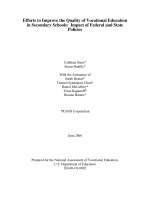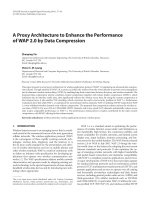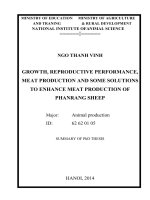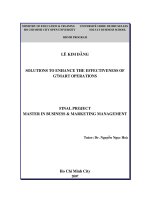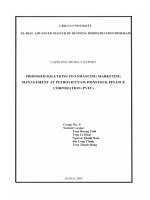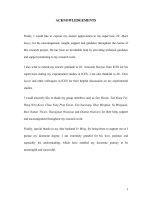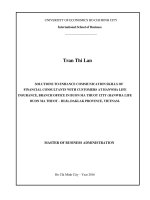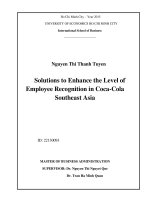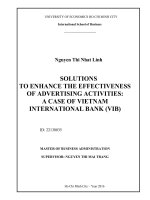SOME SOLUTIONS TO ENHANCE THE PERFORMANCE OF CAPITAL UTILIZATION IN PETROVIETNAM FINANCE CORPORATION (PVFC)
Bạn đang xem bản rút gọn của tài liệu. Xem và tải ngay bản đầy đủ của tài liệu tại đây (1.2 MB, 116 trang )
VIETNAM NATIONAL UNIVERSITY, HANOI
HANOI SCHOOL OF BUSINESS
PHAN THU HA
SOME SOLUTIONS TO ENHANCE THE PERFORMANCE OF CAPITAL
UTILIZATION IN PETROVIETNAM FINANCE CORPORATION (PVFC)
Major: Business Administration
Code: 60 34 05
MASTER OF BUSINESS ADMINISTRATION THESIS
SUPERVISOR: DR. NGUYEN VIET DUNG
HANOI - 2012
ACKNOWLEDGEMENTS
I would like to express my deepest gratitude to my supervisor, Dr. Nguyen Viet
Dung for his constructive suggestions, for his patience, enthusiasm, immense
knowledge, and also continuous encouragement throughout my research.
I would like to take this opportunity to express my faithful thanks to all members at
Hanoi School of Business for their incessant support during my study. I also deeply
appreciate their great contribution to the success of the highly qualified MBA
course which provided me invaluable knowledge and assistance to complete my
research topic.
Last but not least, I owe my loving thanks to my parents for supporting me
spiritually throughout my life. Without their encouragement and understanding it
would have been impossible for me to finish this work.
28/08/2012
Phan Thu Ha
i
ABSTRACT
SOME SOLUTIONS TO ENHANCE THE PERFORMANCE OF CAPITAL
UTILIZATION IN PETROVIETNAM FINANCE CORPORATION (PVFC)
Phan Thu Ha
MBA candidate, 2009-2011
Hanoi School of Business – Vietnam National University, Hanoi
Supervisor: Dr. Nguyen Viet Dung
August 2012,104 pages
Currently, many State Economic Groups have established their finance company
aiming at a more efficient use and allocation of capital. However, the operation in
practice still demonstrates the insufficient capital use. In the context of the overall
restructuring the economy, the restructuring of the entire financial and banking system
is considered a key issue. For a large-scale finance company as PVFC, there is a the big
question about how to enhance the performance of capital use in PVFC to contribute to
the development of the Group, thereby contributing to common national economic
development goals in the context of economic integration.
The study includes the following contents:
This Thesis has presented the theoretical framework of the capital using activities
in finance companies and described some assessment criteria on the performance of
those activities. At the same time, this Thesis has explained the different types of
risk which affect the capital using process, together with the quantitative indicators
in order to develop proper assessments on the concerned risks.
Providing detailed analysis on the status of current activities of capital use in
PVFC, besides some achievements, author’s analysis has proven the weaknesses in
performance of PVFC, which can be observed through the increasing NPL ratio,
ii
poor liquidity, strong reliance on inter-bank market, inappropriate assets-liabilities
structure
Making proposal of some solutions including specific solutions for capital
mobilization, credit, and investment activities, besides, the author has presented the
overall solutions, for instance, improvement and innovation in technology,
enhancement of management capability and internal control, marketing, human
resources solutions ... and a number of recommendations to improve the efficiency
of the capital use in PVFC.
iii
TÓM TẮT
MỘT SỐ GIẢI PHÁP NÂNG CAO HIỆU QUẢ SỬ DỤNG VỐN TẠI TỔNG
CÔNG TY TÀI CHÍNH CỔ PHẦN DẦU KHÍ VIỆT NAM (PVFC)
Phan Thu Hà
Khoa Quản trị Kinh doanh- Đại học Quốc gia Hà Nội
Hướng dẫn: Tiến sỹ Nguyễn Việt Dũng
Tháng 8 năm 2012, 104 trang
Hiện nay nhiều Tập đoàn Kinh tế Nhà nước đã thành lập công ty tài chính nhằm
mục đích sử dụng nguồn vốn hiệu quả hơn. Tuy nhiên, thực tế hoạt động cho thấy
vấn đề hiệu quả sử dụng vốn còn nhiều bất cập. Trong bối cảnh tái cấu trúc tổng thể
nền kinh tế, nội dung tái cấu trúc hệ thống tài chính ngân hàng được xem là một vấn
đề trọng tâm. Đối với một công ty tài chính có quy mô tài sản lớn như PVFC, một
câu hỏi lớn được đặt ra là làm sao để tăng cường hiệu quả sử dụng nguồn vốn của
PVFC để góp phần vào sự phát triển của toàn Tập đoàn, từ đó góp phần thực hiện
mục tiêu phát triển kinh tế quốc gia trong thời kỳ hội nhập kinh tế.
Đề tài nghiên cứu bao gồm những nội dung chính sau đây:
Luận văn đã làm rõ khung lý thuyết nền tảng về hoạt động sử dụng vốn của công
ty tài chính và đưa ra các nhóm chỉ tiêu đánh giá hiệu quả hoạt động này, đồng thời
làm rõ các yếu tố rủi ro ảnh hưởng đến quá trình sử dụng vốn của công ty tài chính
cùng với các chỉ tiêu định lượng để đánh giá các loại rủi ro này.
Đưa ra phân tích cụ thể về thực trạng hoạt động sử dụng vốn hiện nay tại PVFC,
bên cạnh một số kết quả đạt được, phân tích của tác giả chứng minh được hiệu quả
hoạt động yếu kém của PVFC được thể hiện qua tỷ lệ nợ xấu tăng, tính thanh khoản
thấp, lệ thuộc vào thị trường liên ngân hàng, cơ cấu tài sản- nguồn vốn chưa hợp lý.
iv
Đề xuất các giải pháp bao gồm giải pháp cụ thể đối với từng hoạt động huy động
vốn, tín dụng, và đầu tư, bên cạnh đó là các giải pháp tổng thể như giải pháp đổi
mới hoàn thiện công nghệ, nâng cao năng lực quản trị- kiểm soát nội bộ, marketing,
giải pháp nguồn nhân lực… và một số khuyến nghị nhằm nâng cao hiệu quả hoạt
động sử dụng vốn tại PVFC.
v
TABLE OF CONTENTS
ACKNOWLEDGEMENTS ...................................................................................... i
ABSTRACT .............................................................................................................. ii
TÓM TẮT ................................................................................................................ iv
TABLE OF CONTENTS ........................................................................................ vi
LIST OF FIGURES ................................................................................................ ix
LIST OF TABLES ....................................................................................................x
LIST OF ABBRIVIATIONS .................................................................................. xi
INTRODUCTION .....................................................................................................1
CHAPTER 1: LITERATURE REVIEW ON THE PERFORMANCE OF
CAPITAL UTILIZATION IN FINANCE COMPANY ........................................5
1.1 Introduction to finance company .......................................................................5
1.1.1 The definition and classification of finance companies .....................................5
1.1.2 The role of finance companies ...........................................................................6
1.1.3 The major activities of finance company ...........................................................9
1.2 Improve the performance of capital use in finance companies ....................12
1.2.1 Definition of capital efficiency ........................................................................12
1.2.2 The needs to improve the performance of capital use in finance companies ..14
1.2.3 Assessment on the performance of capital use in finance company ................15
1.3 Factors affect the performance of capital use in finance company ..............24
1.3.1 The impacts of State policies and regulations ..................................................24
1.3.2 Impacts of the development strategies and mechanism of the parent company
...................................................................................................................................25
1.3.3 The internal factors of the finance company ....................................................27
vi
CHAPTER 2: ASSESSMENTS ON THE PERFORMANCE OF CAPITAL
UTILIZATION IN PVFC.......................................................................................31
2.1 Overview of PetroVietnam Finance Joint Stock Corporation (PVFC) .......31
2.1.1 Company introduction ......................................................................................31
2.1.2 Scope of business .............................................................................................33
2.1.3 Business performance of PVFC in recent years...............................................35
2.2 Assessment on the performance of capital utilization in PVFC ...................43
2.2.1 Assessment of capital mobilization activities ..................................................43
2.2.2 Assessment of capital utilization ......................................................................47
2.2.3 Analysis of performance indicators of capital efficiency ...............................55
2.3 Achievements, limitations and causes .............................................................67
2.3.1 Achievements ...................................................................................................67
2.3.2 Limitations and causes .....................................................................................68
CHAPTER 3: SOLUTIONS TO ENHANCE THE PERFORMANCE OF
CAPITAL UTILIZATION IN PVFC ...................................................................74
3.1 Opportunities and challenges for PVFC and its development orientation ..74
3.1.1 Opportunities and challenges ...........................................................................74
3.1.2 PVFC’s development orientation .....................................................................76
3.2 Solutions to improve the efficiency of capital use at PVFC ..........................76
3.2.1 Solutions to enhance capital mobilization activities ........................................76
3.2.2 Solutions to improve the performance of credit activities ...............................80
3.2.3 Solutions to improve the performance of financial investment, project
investment .................................................................................................................87
3.3 The overall solutions for PVFC .......................................................................90
3.3.1 Investment, innovation, improvement in banking technologies ......................90
3.3.2 Improve the capability of assets- liabilities management ................................91
3.3.3 Enhancing the capacity of the internal control system ....................................92
vii
3.3.4 Marketing solutions ..........................................................................................93
3.3.5 Focus on developing human resources ............................................................94
3.4 Recommendations .............................................................................................95
3.4.1 Recommendations for SBV..............................................................................95
3.4.2 Recommendations for PVN .............................................................................97
CHAPTER SUMMARY .........................................................................................99
CONCLUSION ......................................................................................................100
BIBLIOGRAPHY .................................................................................................102
viii
LIST OF FIGURES
Figure 2.1: The structure of capital contribution of PVFC .......................................31
Figure 2.2: The chartered capital of finance companies under Vietnam economic
groups ........................................................................................................................32
Figure 2.3: Growth of total assets over the years ......................................................36
Figure 2.4: Asset structure of PVFC in 2011 ............................................................36
Figure 2.5: Capital structure of PVFC in 2011 .........................................................37
Figure 2.6: PVFC’s revenue growth and structure over the years ............................40
Figure 2.7: PVFC’s growth of profit before tax over the years ................................40
Figure 2.8: Growth of mobilization activities from customers’ deposits and issuance
of valuable papers .....................................................................................................44
Figure 2.9: Growth and structure of loans by term over the years ...........................50
Figure 2.10: Growth of investment activities over the years ....................................51
Figure 2.11: Profit/ loss of PVFC’s investment activities over the years .................51
Figure 2.12: Growth of total assets and ROE of PVFC, VPB, and SHB.................57
Figure 2.13: Loan classification by quality in 2011..................................................61
ix
LIST OF TABLES
Table 2.1: Growth of total assets over the years .......................................................35
Table 2.2: Some business indicators of PVFC ..........................................................39
Table 2.3: PVFC’s revenue structure over the years ................................................41
Table 2.4: Capital structure by mobilized sources ...................................................43
Table 2.5: Structure of trusted funds .........................................................................46
Table 2.6: Growth rate of loan balances over the years ............................................47
Table 2.7: Structure of loans and advances to customers by term ............................48
Table 2.8: Investment securities of PVFC ................................................................52
Table 2.9: Long-term investment and capital contribution .......................................54
Table 2.10: Comparison table of performance indicators between PVFC and VPB,
SHB, and banking sector’s average data in two year 2009 and 2011 .......................56
Table 2.11: Quality classification of loans................................................................60
Table 2.12: NPL and overdue debt ratios ................................................................61
Table 2.13: Some indicators for liquidity assessment...............................................63
x
LIST OF ABBRIVIATIONS
PVFC
PetroVietnam Finance Corporation
PVN
PetroVietnam
SBV
State Bank of Vietnam
MSIHI
Morgan Stanley International Holdings Inc
VPB
Vietnam Prosperity Joint-Stock Commercial Bank
SHB
Sai Gon-Ha Noi Commercial Jointstock Bank
ROA
Return on Assets
ROE
Return on Equity
NIM
Net Interest Margin
CAR
Capital Adequacy Ratio
LDR
Loan to Deposit Ratio
NPL
Non performing loans
ICRRS
Internal credit risk rating system
xi
INTRODUCTION
1. Necessity of the thesis
Vietnam has been shifting from the centralized economy towards the market
economy and continues its integration into the global economy. The development
and utilization of financial resources plays an important role in developing Vietnam
economy. The establishment of financial intermediaries including finance
companies in recent decades has contributed significantly to provide a more
efficient allocation of capital, channeling the capital from people who lack of
effective investment opportunity to the person who are capable of investing such
capital resource to produce goods and service in a more effective way.
Regarding the development of economy, it should be aware of the strong
development and contribution of State economic groups that are engaged in multisectors businesses. However, together with the development and expansion of those
businesses, there is a big question of how to mobilize and utilize the capital
resources effectively. As the result, this leads to the establishment of finance
company under the State economic groups to facilitate the capital allocation among
the member companies as well as individuals and organizations from different
economic sectors.
Vietnam Oil and Gas Group is the leading State own economic group with
numerous successful projects which bring remarkable benefit to our country’s
society and contribute significantly to state budget. In order to better manage the
capital resources from the capital-surplus area to the capital-shortage areas as well
as attracting more capital from outside the Group, in 2000, the PetroVietnam
Finance Company, now known as PetroVietnam Finance Corporation, was
established to perform this essential function. With more than ten years of
experience, besides some achievements that the Corporation accomplished, there
are still difficulties and challenges ahead that require the Company seeks
appropriate measures to overcome such limitations.
1
Among the continuously fluctuated situation of global finance, with the purpose of
conducting the research on the operations of mobilizing and using capital of PVFC
as well as figure out some practical solutions to promote its performance in order to
contribute to the development of Petrovietnam, I choose the topic “Some solutions
to enhance the performance of capital utilization in PetroVietnam Finance
Corporation (PVFC)”.
2. Research aim and objectives
The overall aim of the study is to analyze and assess the current practices of capital
utilization and to make suggestions to enhance the performance of this operation in
PVFC. The thesis aims to achieve the following objectives:
(1) Systemize the theoretical framework of finance companies in general and the
capital utilization in particular. In addition, a set of assessment criteria will be
discussed to evaluate the performance of the capital use in a finance company.
(2) Develop the detailed analysis and assessments on the actual situation of capital
utilization in PVFC.
(3) Propose some practical suggestions and recommendations for the enhancement
of capital utilization in PVFC
3. Scope of the research
The overall business performance of a finance company is a broad topic. Therefore,
this thesis only focuses on the performance of capital utilization in PVFC from year
2008 to year 2011, including three main activities that directly related to the topic,
which are the capital mobilization, credit activity, and investment activity in order
to develop suggestions and recommendations to enhance the performance of capital
use in PVFC
2
4. Research methodology
The main sources of data are selectively collected from secondary sources including
both local and foreign materials such as data collected from the researched company,
from other banks, books, internet, magazines, science reviews, and related journals
The methods applied in this study include: logical reasoning combined with
historical materialism, quantitative and qualitative analysis, statistic method,
comparison method, economic analysis, method of synthesizing... to evaluate the
performance of capital utilization in PVFC.
5. Significance of the research
This thesis identifies numerous weaknesses in the current utilization of capital in
PVFC; helps PVFC recognize and have further actions in solving its shortcomings.
This thesis has proposed some practical solutions in order to enhance the
performance of capital use in PVFC case which is the foundation for the
improvement in the capital allocation among PVN and its members.
Based on the same business environment and same operating models, other finance
companies under the State economic groups are suffering the same issues as PVFC.
Therefore, the recommendations for PVFC provided in this thesis can be seen as a
practical case study for other finance companies to consider and apply into their
businesses.
6. Limitation of the thesis
The research focuses on the performance of capital use in PVFC. Due to time and
ability constraints, the thesis is not capable of covering a large size of data and
information.
The limited capability to approach the necessary primary data, the data used in this
research is mainly collected from secondary sources.
3
At the time of conducting this research, the researched company is currently
processing the procedure to transform its business model; in addition, the economic
and financial situation is changing rapidly. Therefore, the results of this research
will be limited in the practical application after the model transformation; the
proposed solutions could be applied in short-term rather than long-term objective.
7. Thesis structure
Thesis topic: “Some solutions to enhance the performance of capital utilization in
PetroVietnam Finance Corporation (PVFC)”
Introduction
Chapter 1: Literature review on the performance of capital utilization in finance
company
Chapter 2: Assessments on the performance of capital utilization in PVFC
Chapter 3: Solutions to enhance the performance of capital utilization in PVFC
Conclusion
4
CHAPTER 1: LITERATURE REVIEW ON THE PERFORMANCE
OF CAPITAL UTILIZATION IN FINANCE COMPANY
1.1 Introduction to finance company
1.1.1 The definition and classification of finance companies
Finance company is a form of non-bank financial institution with the function of
using the financial sources including its own capital, customer deposits and other
funds for the purposes of lending, investment, providing advisory services in
finance, monetary fields, as well as perform some other services as prescribed by
law, but are not allowed to provide the payment service or receive deposits with
term of less than 1 year as a commercial bank.
Classification by business activities, finance companies can be divided into three
main types as follows:
First, sale finance company
These companies indirectly grant credit to consumers to purchase goods from a
retailer or from a certain manufacturer. This type of finance company is often
established by the retailing or manufacturing company to support the consumption
of their commodities. For instance, in the U.S., General Motors Acceptance
Corporation specializes in providing financial supports for car buyers of GM.
Second, consumer finance company
This kind of finance company provides the majority of their capital for the
household and individual loans for the purpose of purchasing consumer goods such
as furniture, home appliances or repairs. Most of the loans are made under
installments with higher interest rates compared to the market interest rates because
these loans often contain high risks.
Third, business finance company
5
This type of finance company provides credit for businesses under the forms of
factoring and forfeiting, discounting the receivables of the businesses, or leasing,
these companies provide loans to purchase machinery according to customer’s
needs, then lease those items to customers, etc. [7,17]
Based on the relationship of ownership, Finance companies are divided into
First, the independent finance company which performs numerous operations, such
as credit operations including loans and guarantees to commercial and
manufacturing customers, the leasing of property; factoring; currency trading;
financial advisory ...
Second, the finance company established by economic groups is primarily engaged
in the following activities: seeking investment capital to provide for the members of
the group, management and investment of unused funds in corporations, managing
and channeling the temporarily idle funds among the group’s members; being the
hub and providing advisory to the group and its members in order to build relations
with banks and investment partners; management and application of measures to
prevent financial risks within the group; providing financial advisory services to the
member companies ... besides that, the company also provides financial services for
external customers such as loans to buy goods produced by the corporation, and
other financial advisory services ...
1.1.2 The role of finance companies
The role of the finance company for the economy in general
The history of economic development of many countries shows that, in the market
economy, finance companies always exist and become increasingly popular. The
funds allocated dispersedly in the population and economic organizations can be
gathered for long-term capital needs of a specific industry, a certain area, and the
overall economy.
6
Because of few limitations, finance company is able offer loans to meet the diverse
needs of customers in a more convenient manner compared to commercial banks.
Through the activities of finance company, capital in society can be agglomerated to
serve the capital needs of the economy as well as other long-term investments.
Activities of these companies contribute to the expansion of the stock market. The
operation of finance company on the stock market helps ensure sustainable stability
of the market, ensure the safety and improve the business performance of those
companies.
In short, finance company is a financial intermediary in the economy market,
despite some limitations compared to commercial banks, for the market economy,
finance companies play an important role as follows:
Firstly, finance companies generate capital for investments to develop the economy
based on advantages of wide branch-network, providing variety of products and
services. Facilitating the needs of borrowers and lenders via activities of capital
mobilization and credit business
Second, through the credit activities, finance companies facilitate the sustainability
and expansion of businesses of all economic sectors.
Third, finance companies strengthen the development of securities markets, through
the issuance of the major instruments of financial markets, for instance debentures,
bonds and shares.
Forth, finance companies also play the role as an important channel for capital
flows of foreign investment. With its functions, finance company can provide
consultancy to both local and foreign investors on the methods and forms of
investment, how to promote effective management of capital investment. [8,20]
The role of finance companies in economic groups
For finance companies operating under economic groups, thanks to better
understanding of business activities of member companies, and capturing more
7
internal information, they can provide loans to the customers of the member
companies which help generate higher revenue. The key roles of finance companies
in economic groups are:
First, the establishment of finance companies in economic groups help expand
business operations, diversify businesses, reduce risk and generate new source of
revenues from those industries of high profitability, finance company in economic
group has better conditions and ability compared to a commercial bank in term of
managing the financial risks for the member companies.
Second, the establishment of finance companies under economic groups assists
those groups in seeking and mobilizing external funding channels through the
determination of the methods of raising capital, the amount of capital needed,
deposits’ period, lending and repayment terms ... to timely meet the capital needs of
parent company at the lowest possible cost.
Third, the establishment of finance companies helps holding companies effectively
manage the optimal capital through ensuring the investment to be in line with the
overall development orientation, selecting the most potential projects of high
economic profitability, thereby improving business performance of the group.
Fourth, the establishments of finance companies help parent companies to harness
the power on the financial and monetary market through the unified and centralized
management of financial resources, regulating the temporarily idle funds, ensuring
flexible management of capital, maximizing internal capacity through the
implementation of currency trading and participating in the financial and monetary
markets both locally and overseas.
Fifth, the establishment of finance companies in economic groups help facilitate
activities of the group towards a systematic, centralized and uniform orientation;
economic groups have large advantages in term of development resources, vast market,
governments often promote policies to encourage and create favorable conditions for
economic groups including the finance companies under those groups. [8,20]
8
1.1.3 The major activities of finance company
1.1.3.1 Mobilization activities
Capital mobilization from customers
Finance companies in economic groups can borrow funds from the organization
customers, however only medium and long term capitals with term of equal or over
12 months are allowed according to the regulations of the law on credit institutions.
Issuance of shares, bonds, debt certificates
Issuance of shares: The prerequisite for the establishment of any finance company
is to have sufficient legal startup capital. Initial charter capital of the company is
contributed by the holding company and/ or its affiliates. In addition, finance
companies can raise more capital from the public sources by issuing shares or bonds
of that finance company.
Issuance of medium and long term bonds: bond is a type of debt certificate,
representing the long-term borrowings of finance company and will be paid off after
a certain period. Bondholders are entitled to a fixed income and depend on the
business results of the finance companies. Finance companies often raise capital in
the form of bonds.
Issuing debt certificates: debentures issued by the finance companies in order to
mobilize capital in the money market to meet the urgent needs for cash or shortterm funds
Borrowings from credit institutions
The finance company under economic group can borrow from the credit institutions
on the principle: credit institutions shall operate according to legal provisions;
lending and borrowing activities shall comply with credit agreement and loans must
be secured by mortgage, pledge or guarantee
Borrowings from parent company
9
Besides the issuance of shares, bonds, certificates of debt or borrowing from other
credit institutions, finance company in economic groups can borrow from its
holding company.
The economic groups, based on the reputation and business advantages, will
mobilize capital through the issuance of bonds, and then transfer the capital to the
finance companies. On the other hand, when the economic group issue bonds, it is
not bound to the regulations on reserve rate, interest rates… by the SBV because
they do not operate as credit institutions.
1.1.3.2 Activities of capital utilization
a.
Lending
A key business activity of finance company in economic groups to generate profits,
incomes from interest rates will offset the costs of capital mobilization, preservation
costs, management costs, taxes, and costs of investment risks. Lending activities are
diverse and abundant including the following forms:
Based on forms of loans, lending activities include:
Advances to customers is provided on the basis of the credit agreement, in
which customers (individuals, businesses) are granted a certain lending amount in
an agreed period. Credit advances contain two types: Secured advances and
advances without guarantee.
Overdraft: also known as credit limit, is a form of credit advances particularly
made on the basis of the credit agreement, in which the customer is allowed to use a
limited credit balance over a specified period.
Commercial paper discounting: a short-term credit operation, the good or
service suppliers provide the commercial papers which represent the goods and
services supplied, then transfer the ownership of those commercial papers to the
finance company which would be paid prior to maturity at par value amount of
commercial paper subtracting interests and commission fees; finance companies are
10
responsible for collecting money from the purchasers of goods and services upon
their maturity.
Based on the types of borrower, lending activities include:
Lending to different business sectors known for business loans, for instance,
lending to industries, trading, services, agriculture, real estate...
Loans to consumers to purchase consumer items such as cars, durable products
such as home repairs, credit cards, personal expenses...
Loans to other credit institutions
Loans to parent company and member companies
Based on the loans’ term, lending activities are divided into:
Short-term loans (loan period less than 1 year)
Medium-term loans (loan period from 1 year to 5 years)
b.
Long-term loans (loans period equal to or over five years)
Investment activities
Investment activities in securities: finance companies in economic groups are also
investors in financial market. Investment securities are the second important source
of profit after the lending business, it also helps companies improve financial
liquidity, reservation, and diversification of business activities in order to diversify
risks and improve the efficiency of business operations of finance companies.
Overall, the finance companies under economic groups usually develop concrete
policies for investment in securities. Portfolios of securities range from the safest
securities as Treasury bonds to relatively safe or the relatively risk securities.
In addition to direct investment in the centralized market, finance companies
participate in the OTC market creating an investment channel to increase the
liquidity and risk diversification.
11
And other financial investments: finance companies also participate in joint
ventures, equity contributions, other long-term investment in projects and
businesses.
In addition to the main activities of mobilization, lending and investment to be
covered within this thesis, finance companies are also engaged in a number of other
activities such as property leasing including operating leases and financial leases,
factoring operations, the issuance services of securities, foreign exchange trading,
and other financial services such as mortgage of commodities, materials, foreign
currencies ... [7,10,17,20]
1.2 Improve the performance of capital use in finance companies
1.2.1 Definition of capital efficiency
Capital is a prerequisite for any business, either engaged in industries or services in
the economy. To conduct business activities, enterprises need to hold a certain
amount of capital.
Capital is the concept which includes all the elements arranged to produce goods
and services. Capital is put into production in various forms. It consists of tangible
assets and intangible assets as well as all the accumulated knowledge of the
business, management and operational levels of leadership as well as staffs’
qualification.
There are different definitions for capital; some of them can be defined as follows:
“Wealth in the form of money or assets, taken as a sign of the financial strength of
an individual, organization,
or
nation,
and
assumed
to
be
available
for development or investment”
In terms of accounting “money invested in a business to generate income”
In terms of
economics “Factors of production that are
used to create
goods or services and are not themselves in the process” (businessdictionary.com)
12
“Cash or goods used to generate income either by investing in a business or a
different income property”
“The money, property,
and
other valuables which
collectively
represent
the wealth of an individual or business” (investorwords.com)
The concept of efficiency can be defined as follows:
“The comparison of what is actually produced or performed with what can be
achieved with the same consumption of resources (money, time, labor, etc.). It is an
important factor in determination of productivity” (www.businessdictionary.com)
“Efficiency in general describes the extent to which time, effort or cost is well used
for the intended task or purpose. It is often used with the specific purpose of
relaying the capability of a specific application of effort to produce a specific
outcome effectively with a minimum amount or quantity of waste, expense, or
unnecessary effort.” (www.wikipedia.com)
First of all, the initial concept of efficiency in general is how to use the resources of
the economy in the most effective way to satisfy the needs and expectations of the
participating parties.
Capital efficiency, or the performance of capital use of a business can be understood
as the relationship between how many expenses are incurred by the company to
how much money is used to manufacture a good or service.
Thus, from the above-mentioned concepts and definitions, in the opinion of the
author: "The effective use of capital in credit institutions in general and finance
companies in particular are assessed in terms of financial performance as the result
of capital activities, reflecting the correlation between the financial performance
and the total capital use, represented through the use of resources, governance
capacity, financial capacity and the level of risk control on the financial activities”
Business process of a finance company requires capital in advanced. The final result
of business operation is the net profit and the ability to maintain safety of the
13
